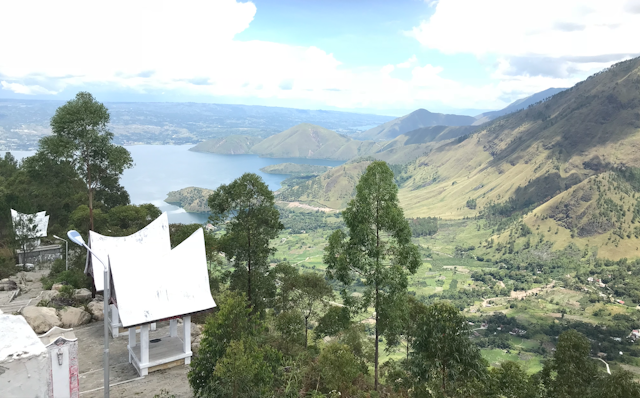In 2017, Indonesia announced an ambitious plan to attract 20 million international tourists by 2019 by developing ten new tourist destinations, dubbing them “the 10 New Balis”.
One of the destinations is the scenic Urat village, a small village in the middle of Samosir Island in Lake Toba, North Sumatra.
To get there, one must take an hour and half hour trip by plane from the capital, Jakarta, to Medan or Silangit airports in North Sumatra province, then travel 30-45 minutes by boat to Samosir island, followed by a four hour drive. This rural tourism destination offers nature, culture, and adventure as its tourism attractions.
Read more: Traditional knowledge helps Indigenous people adapt to climate crisis, research shows
In this research, we studied the relationship dynamics between indigenous peoples, government (policymakers), and local vendors in the process of developing Urat as the main rural tourism destination within North Sumatra.
We found the indigenous Batak people felt that they are being left out of the process of rural tourism development.
Rural tourism development encourages local entrepreneurs to increase trade, which helps in achieving income equality.
The indigenous Batak people in Urat, who mostly have low education levels and work as farmers or construction workers, lack access to the information and funding that would boost their capacity to benefit from the tourism trade.
The Urat Village
Urat is one of the home to the Bataknese (locally known as Batak), the third-largest ethnic group in Indonesia (8.5 million people), after Javanese and Sundanese.
Some 2,000 Bataknese out of 100,000 Bataknese in Samosir Island live in Urat.
We chose Urat for our research as it has received priority from the (local) government as one of the villages in Lake Toba to guide other villages in the development program.
It also shares characteristics with other targeted villages among the ten new destinations, such as: limited infrastructure (public roads, public sanitation), similar social-demographic situations (social status, population), insufficient access to education (limited numbers of schools and teachers), and poor social welfare.

The role of policymakers, indigenous people, and local vendors
In 2017, we conducted a focus group discussion attended by dozens of villagers from various background.
We invited teachers, public servants, construction workers, and farmers to discuss entrepreneurial opportunities in Urat, such as opening home-stays, small coffee shops, souvenir shops, and transportation services.
We also interviewed the head of the village, the Lake Toba Tourism Authority director, and academics.
Based on the focus group and interviews, indigenous people want to try to open small businesses and take advantage of the tourism sector in their village, but they feel unable to compete with non-Indigenous local vendors who are more educated, skilled and have better access to finance and products.
The non-Indigenous vendors mostly come from major cities, such as Medan, Pematang Siantar, and Padang, but have lived as permanent residents in the village.

Due to lack of skills and capital, the Indigenous people feel discouraged to start businesses in their communities. Unable to compete with local vendors, they feel disappointed by the influx of income to local vendors from tourists visiting their ancestral land.

They also feel left out of counselling and training given by the local government to open a start-up business, run a small diner, or keep the public sanitation area clean.
Because most indigenous peoples are farmers and construction workers, they would often skip the meetings due to work obligations.
Meanwhile, non-Indigenous local vendors who already have better access and network than the Indigenous people get to benefit from the training.

The Indigenous people hope governments make a conscious effort to help them participate in the tourism sector, including directly allocating village funds to provide them with capital and training to start and run tourism-related businesses.
How to make it work
Indigenous people in Urat are disadvantaged compared to non-Indigenous local vendors who understand more about “how to do business” and tend to have a better education than indigenous people.
Hence, they feel that the government should prioritise them to receive support in “the 10 New Balis” program so they too can benefit from the development of tourism in their village.
Read more: Can virtual tourism save local businesses in tourist destinations?
The government should not neglect indigenous people in the development of rural tourism. Without the government’s support, indigenous people would only watch how tourists and outsiders enjoy the beauty of their scenic village, while the benefits elude them.
The government should involve indigenous people in community development programs. Currently, indigenous people are included only on certain occasions such as village meetings.
Read more: Study shows Village Forests in Indonesia can protect the environment and reduce poverty
For the government to ensure inclusive development, we strongly recommend the government to improve the education of indigenous people through providing qualified teachers, structured vocational and academic educational programs as well as infrastructure, such as schools, public roads, accommodations and restaurants.
The government should also set up an equity program to encourage creativity and success of indigenous people in entrepreneurship.
This could enable indigenous people to create products that will attract international and domestic tourists. Funding could come from the village budget.
Nevertheless, the government should simplify communications about their programs so indigenous people can understand it.

